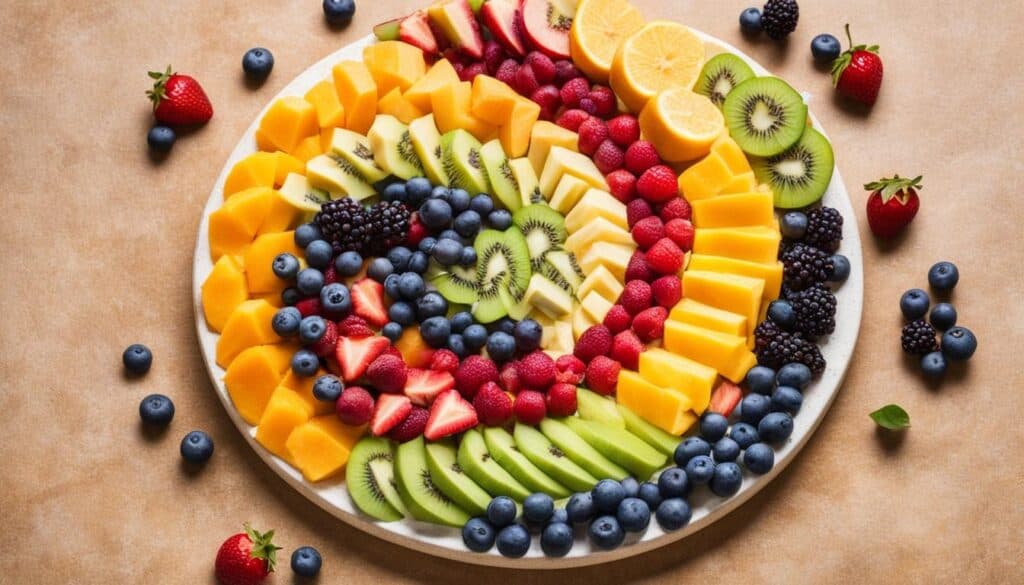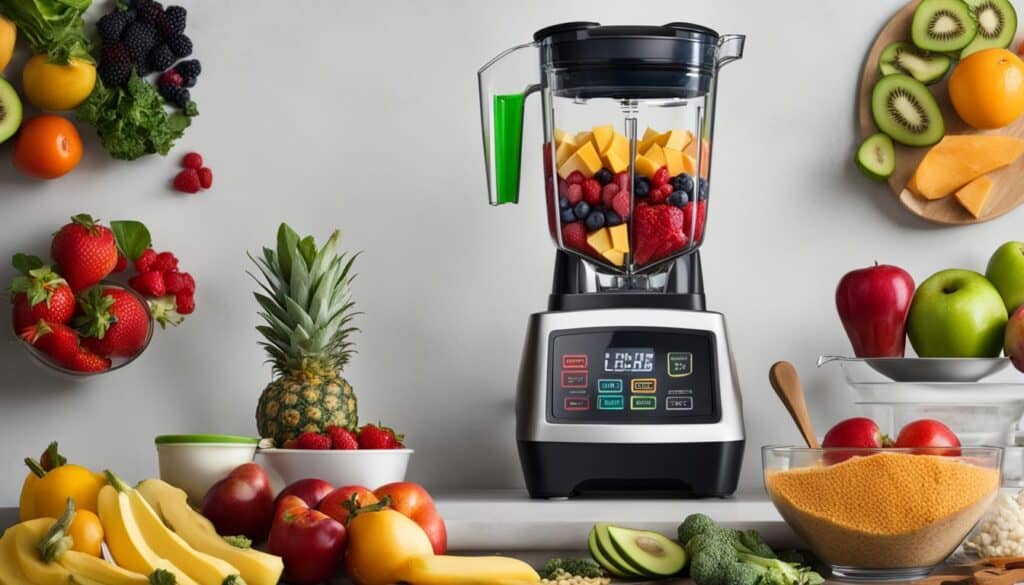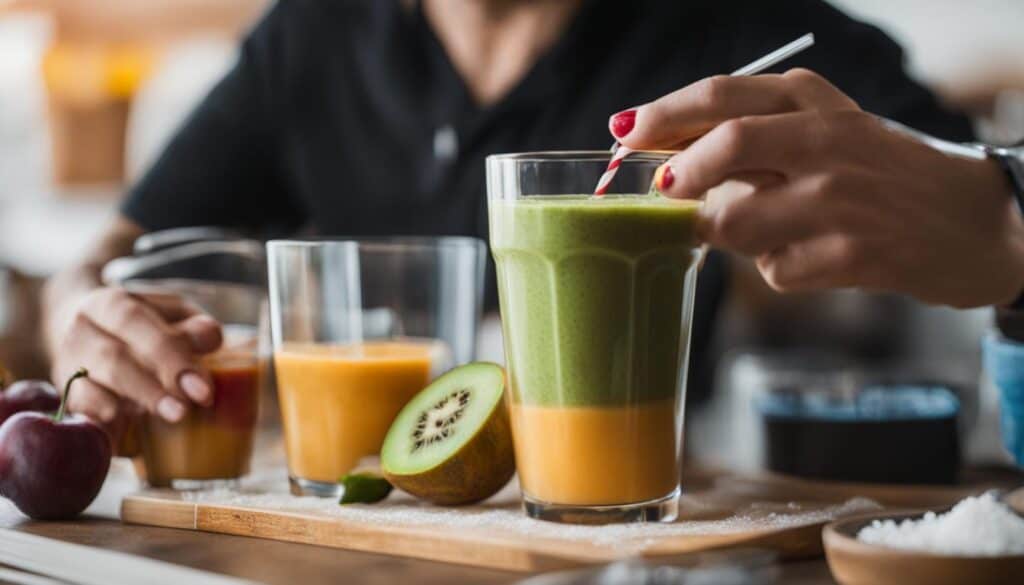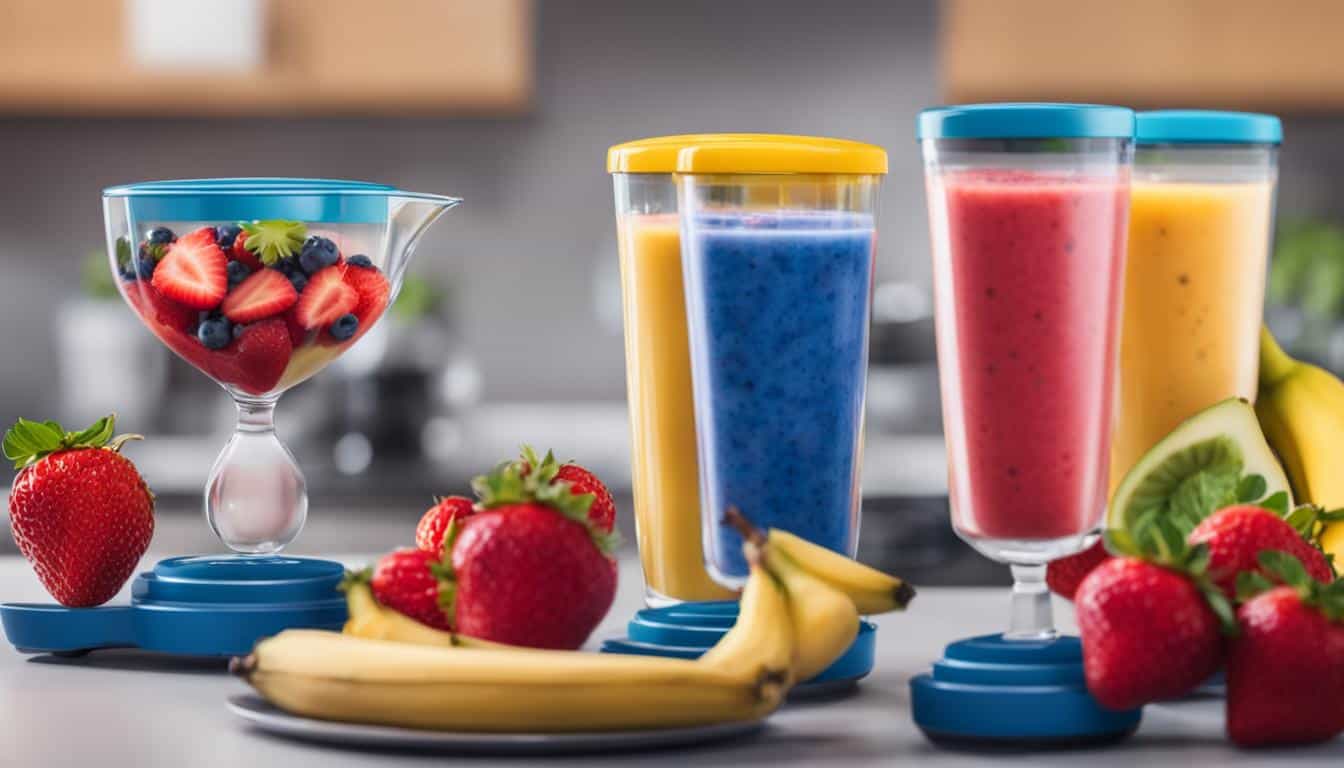Greetings, my fellow health enthusiasts! Today, I want to delve into the delightful world of fruit smoothies and their potential role in weight loss. As a firm believer in the power of natural remedies, I’ve embarked on a journey to uncover the truth behind the question: Can fruit smoothies help lose weight?
Weight loss is a goal that many of us aspire to achieve, and the idea of sipping on a tasty smoothie while shedding those extra pounds sounds appealing. But before we jump to conclusions, let’s examine the evidence and separate fact from fiction.
Throughout my research, I’ve come across various perspectives on this subject, and it’s important to consider all angles. While some endorse the Smoothie Diet as a quick solution for shedding unwanted weight, others caution against its potential pitfalls in the long run.
Key Takeaways:
- Fruit smoothies can be a part of a weight loss journey if consumed correctly and in moderation.
- The Smoothie Diet, while promising fast results, may not be sustainable in the long term and can lead to muscle loss and nutrient deficiencies.
- Incorporating protein sources, like Greek yogurt or protein powder, in smoothies can increase satiety and aid in weight loss.
- Balancing macronutrients, such as protein, healthy fats, and carbohydrates, is essential for creating a balanced meal replacement.
- Watch sugar intake by using lower-sugar fruits and avoiding added sugars or sweeteners to prevent blood-sugar swings and weight gain.
Now that we’ve scratched the surface, let’s dive deeper into the Smoothie Diet and explore the benefits of fruit smoothies for weight loss.
How Does The Smoothie Diet Work?
The Smoothie Diet is a popular approach for sustainable weight loss that involves replacing at least two meals per day with low-calorie detox smoothies. By creating a calorie deficit, this diet can effectively support weight loss goals. The Smoothie Diet is designed to be followed for three weeks, and it provides users with a digital recipe book containing a variety of smoothie recipes to ensure a diverse and enjoyable experience.
However, it’s important to note that while The Smoothie Diet can lead to initial weight loss, experts caution that it may not provide sufficient protein and other essential nutrients for long-term sustainability. It’s crucial to maintain a balanced and nutrient-rich diet to support overall health and well-being.
“The Smoothie Diet is an effective way to kickstart weight loss by incorporating low-calorie detox smoothies into your daily routine. However, it’s essential to remember that sustainable weight loss requires a well-rounded and nourishing diet plan.” – Nutritionist Emma Johnson
Benefits of Fruit Smoothies for Weight Loss
Fruit smoothies can be a delicious and effective addition to your weight loss journey. When made and consumed correctly, they provide a range of benefits that can support your weight loss goals.
One of the main advantages of fruit smoothies is that they are nutrient-dense. They contain a variety of fruits, which are packed with essential vitamins, minerals, and fiber. These nutrients help nourish your body and support overall health during your weight loss journey.
Smoothies can also be an excellent source of protein when made with ingredients such as Greek yogurt or protein powder. Protein is a crucial component of weight loss as it aids in increasing satiety and promoting a feeling of fullness. Additionally, protein helps preserve lean muscle mass, which is important for maintaining a healthy metabolism and promoting long-term weight management.
When creating your fruit smoothies, consider including a mix of fruits and vegetables. This adds important dietary fiber, which can further promote feelings of fullness, aid digestion, and support healthy weight loss. Fiber also helps regulate blood sugar levels, preventing spikes and crashes that can lead to cravings and overeating.
Try experimenting with different combinations of fruits, vegetables, and protein sources to create a customized smoothie that suits your taste preferences and weight loss goals. Here’s an example recipe:
| Ingredients | Amount |
|---|---|
| Frozen mixed berries | 1 cup |
| Baby spinach | 1 handful |
| Plain Greek yogurt | 1/2 cup |
| Almond milk | 1 cup |
| Chia seeds | 1 tablespoon |
| Ice cubes | Handful |
Simply blend all the ingredients together until smooth, and enjoy a nutritious and satisfying smoothie that can support your weight loss efforts.
Potential Pitfalls of The Smoothie Diet

While the Smoothie Diet may initially lead to weight loss, it is essential to be aware of its potential pitfalls. In my research, I found that this diet can result in the loss of lean muscle mass instead of fat, which can be detrimental to your overall health and fitness goals.
Furthermore, the Smoothie Diet’s focus on liquid meals can lead to nutritional deficiencies. By restricting solid food intake, you may not be consuming enough essential nutrients, vitamins, and minerals that your body requires for optimal functioning and well-being.
“Not only is the drastic reduction in calories unsustainable, but it can also contribute to muscle loss and nutritional deficiencies” warns Dr. Jennifer Smith, a renowned nutritionist.
“The Smoothie Diet’s emphasis on rapid weight loss may seem appealing, but it often results in yo-yo dieting and a cycle of weight regain.”
It’s important to understand that the rapid weight loss achieved through this diet may be difficult to sustain in the long term. As a result, many individuals may find themselves in a continuous loop of losing and gaining weight, which can be frustrating and detrimental to their overall well-being.
To illustrate the potential pitfalls of the Smoothie Diet, refer to the table below:
| Potential pitfalls of the Smoothie Diet | Effects on the body |
|---|---|
| Lack of lean muscle loss | Decreased metabolism, loss of strength and endurance |
| Nutritional deficiencies | Weak immune system, low energy levels, impaired cognitive function |
| Yo-yo dieting | Mood swings, reduced self-esteem, increased risk of disordered eating patterns |
It is crucial to consider the potential drawbacks of any weight loss program, including the Smoothie Diet.”
Dos and Don’ts of Making Weight Loss Fruit Smoothies
When it comes to making weight loss fruit smoothies, there are certain dos and don’ts to keep in mind. Following these guidelines will help you create healthy and nutritious smoothies that support your weight loss goals.
Do Include Protein Sources
One of the dos of making weight loss fruit smoothies is to include protein sources in your recipes. Protein plays a crucial role in boosting satiety and keeping you feeling fuller for longer. It also helps preserve muscle mass, which is important for a healthy metabolism.
“Including protein sources like Greek yogurt or protein powder in your smoothies can help increase their weight loss benefits and make them more satisfying.”
Do Use a Variety of Fruits and Vegetables
Another important do is to use a variety of fruits and vegetables in your smoothies. Different fruits and vegetables offer a range of vitamins, minerals, and antioxidants that support overall health and weight loss. Adding a mix of colorful produce will not only enhance the nutritional value but also add refreshing flavors to your smoothies.
Don’t Add Excessive Sugar
One of the don’ts of making weight loss fruit smoothies is to avoid adding excessive amounts of sugar. While fruits naturally contain sugars, it’s important to be mindful of the added sugars in your smoothies. Avoid using fruit juices or sweetened syrups, as they can significantly increase the calorie and sugar content of your smoothies.
Don’t Rely Solely on Smoothies for Nutrition
While weight loss fruit smoothies can be a valuable addition to your diet, it’s essential not to rely solely on them for nutrition. Smoothies are not meant to replace balanced meals that provide a wide range of nutrients. Make sure to consume a diverse and balanced diet that includes whole foods to ensure you’re getting all the necessary nutrients for optimal health.
Summary
To make weight loss fruit smoothies effectively, remember to include protein sources like Greek yogurt or protein powder for satiety, use a variety of fruits and vegetables for added nutrients, avoid excessive sugar, and combine smoothies with a balanced diet. By following these dos and don’ts, you can create delicious and nutritious smoothies that support your weight loss journey.
| Do | Don’t | |||
|---|---|---|---|---|
| Include protein sources like Greek yogurt or protein powder | Avoid excessive sugar, such as fruit juices or sweetened syrups | |||
| Use a variety of fruits and vegetables | Don’t rely solely on smoothies for nutrition |
The Importance of Protein in Fruit Smoothies
Protein plays a crucial role in weight loss, making it an essential nutrient to include in your fruit smoothies. Not only does protein help increase satiety, keeping you fuller for longer, but it also aids in reducing cravings. Including protein sources in your smoothies can be a game-changer in achieving your weight loss goals.
The significance of protein lies in its ability to support muscle growth and maintenance. When you’re trying to lose weight, preserving muscle mass is important for a healthy metabolism. Protein helps prevent muscle loss and ensures that your body burns fat instead of valuable muscle tissue.
There are several protein options you can consider for your fruit smoothies. Greek yogurt is an excellent choice, providing not only protein but also a creamy texture. You can also add protein powder for an extra boost or incorporate nuts for a delightful crunch and added protein content.
“Protein is a key player in weight loss, promoting satiety and supporting muscle mass.”
By including protein in your fruit smoothies, you’re creating a well-rounded and nutritious meal replacement. It helps balance your blood sugar levels, prevents hunger pangs, and keeps you feeling satisfied throughout the day. Protein in smoothies is a winning combination for achieving sustainable weight loss.
Incorporating protein sources into your fruit smoothies can be as simple as adding a few tablespoons of Greek yogurt or a scoop of protein powder. Experiment with different combinations and flavors to find the ones that suit your taste preferences and weight loss goals. Remember, variety is key when it comes to achieving a well-rounded nutritional profile.
Balancing Macros in Fruit Smoothies for Weight Loss
When it comes to weight loss, balancing macronutrients in your fruit smoothies is key. By including a mix of protein, healthy fats, and carbohydrates, you can create a well-rounded meal replacement that supports your weight loss goals.
Protein is an essential component of any weight loss plan. It helps increase satiety, keeping you feeling full for longer and reducing unhealthy cravings. Good sources of protein to include in your fruit smoothies are Greek yogurt, protein powder, or even cottage cheese.

Healthy fats also play an important role in your smoothies. They contribute to feelings of fullness and help stabilize blood sugar levels. Adding a tablespoon of nut butter, such as almond or peanut butter, can provide a healthy dose of fats to keep you satisfied.
Carbohydrates are essential for providing energy and fueling your body. Including fruits in your smoothies is a great way to add natural carbohydrates, along with important vitamins, minerals, and fiber.
Examples of Balancing Macros in Fruit Smoothies:
| Protein | Healthy Fats | Carbohydrates |
|---|---|---|
| Greek yogurt | Almond butter | Strawberries and bananas |
| Protein powder | Peanut butter | Blueberries and spinach |
| Cottage cheese | Avocado | Mango and pineapple |
Remember, each person’s nutritional needs may vary, so it’s important to consult with a healthcare professional or registered dietitian to determine your specific requirements for weight loss.
By balancing macros in your fruit smoothies, you can create delicious and nutritious meals that support your weight loss journey. Experiment with different combinations to find the flavors and ingredients that work best for you.
Watching Sugar Intake in Fruit Smoothies
When it comes to making fruit smoothies for weight loss, it’s important to pay attention to your sugar intake. While fruits are a natural source of sugars, consuming them in large quantities can lead to potential blood-sugar swings and weight gain.
To create healthier smoothies, try using lower-sugar fruits like berries, citrus fruits, and apples. These choices are packed with vitamins, minerals, and fiber while being lower in natural sugars compared to tropical fruits like bananas and mangoes. Incorporating vegetables such as spinach or kale into your smoothies can also help balance the sugar content and boost nutritional value.
Avoiding added sugars or sweeteners is another crucial step in managing sugar intake. Many commercial smoothie mixes, juices, and yogurt products contain added sugars that can quickly increase the sugar content and calorie count of your smoothie. Opt for unsweetened yogurt, and if you need a touch of sweetness, try adding a small amount of honey or a natural sweetener like stevia.
Balancing sweetness with other macronutrients, such as protein, healthy fats, and fiber, is another effective strategy. These components can help prevent blood-sugar spikes and promote feelings of satiety, keeping you full and satisfied for longer. Including ingredients like Greek yogurt, nuts or nut butter, and chia seeds in your smoothies can provide the necessary balance and support your weight loss goals.
Being mindful of your sugar intake when making fruit smoothies is essential for maintaining stable blood-sugar levels and achieving weight loss. By choosing lower-sugar fruits, avoiding added sugars, and balancing sweetness with protein, healthy fats, and fiber, you can enjoy delicious and nutritious smoothies without the risk of blood-sugar swings.
“Balancing sweetness with other macronutrients is key in managing sugar intake and preventing blood-sugar swings.”
Here’s a table showcasing the sugar content of common fruits:
| Fruit | Serving Size | Sugar Content |
|---|---|---|
| Strawberries | 1 cup | 7 grams |
| Blueberries | 1 cup | 15 grams |
| Apples | 1 medium | 19 grams |
| Bananas | 1 medium | 14 grams |
| Mangoes | 1 cup | 23 grams |

Incorporating Fiber into Weight Loss Fruit Smoothies
When it comes to weight loss, fiber is an essential component that you shouldn’t overlook. Not only does fiber aid in digestion, but it also promotes satiety, helping you feel full for longer periods. By incorporating fiber-rich ingredients into your fruit smoothies, you can boost their nutritional value and enhance your weight loss journey.
Here are some fantastic sources of fiber that you can add to your smoothies:
- Chia seeds
- Flaxseeds
- Oats
These fiber-packed ingredients not only provide bulk and texture to your smoothies but also contribute to a long-lasting feeling of fullness. By keeping you satisfied for hours, fiber can help prevent overeating and cravings, ultimately supporting your weight loss efforts.
While blending fruits and vegetables may slightly reduce their fiber content, don’t worry. You can still meet your fiber needs by incorporating additional sources, such as chia seeds, flaxseeds, or oats, into your smoothies.
Delicious Fiber-Rich Fruit Smoothie Recipe
Here’s a delectable recipe that combines the benefits of fiber with the goodness of fruits:
“Berry Blast Smoothie”
Ingredients:
| Ingredients | Amount |
|---|---|
| Frozen mixed berries (strawberries, blueberries, raspberries) | 1 cup |
| Chia seeds | 1 tablespoon |
| Spinach | 1 cup |
| Almond milk (unsweetened) | 1 cup |
| Protein powder (optional) | 1 scoop |
| Ice cubes | Handful |
Instructions:
- In a blender, combine the frozen mixed berries, chia seeds, spinach, almond milk, protein powder (if using), and ice cubes.
- Blend until smooth and creamy.
- Pour into a glass and enjoy!
This refreshing and fiber-rich smoothie is not only delicious but also a great addition to your weight loss journey. Feel free to customize it by adding more of your favorite fruits or adjusting the consistency with almond milk or ice cubes.
Remember, incorporating fiber into your fruit smoothies can help you stay on track with your weight loss goals and maintain a healthy lifestyle.
Conclusion
In conclusion, fruit smoothies can be a beneficial addition to a weight loss journey when consumed as part of a well-balanced diet. These delicious beverages provide essential nutrients, fiber, and protein, supporting overall health and satiety. However, it’s crucial to be aware of portion sizes and the sugar content of the ingredients used.
To ensure success with fruit smoothies for weight loss, it’s important to prioritize a variety of fruits and vegetables in your recipes. Opt for lower-sugar fruits and incorporate sources of protein, such as Greek yogurt or protein powder, to enhance satiety and muscle support. Balancing macros, including healthy fats, carbohydrates, and protein, creates a satisfying and nourishing meal replacement.
While fruit smoothies can be a helpful tool for weight loss, it’s important to remember that they should not replace a well-rounded diet. Long-term sustainability is vital in achieving and maintaining weight loss goals. Focus on developing healthy eating habits that include a variety of nutrient-dense foods alongside properly portioned smoothies.
FAQ
Can fruit smoothies help with weight loss?
Fruit smoothies can be beneficial for weight loss when made and consumed correctly. They can be nutrient-dense, providing essential vitamins, minerals, and fiber.
How does the Smoothie Diet work?
The Smoothie Diet involves replacing at least two meals per day with low-calorie detox smoothies, creating a calorie deficit and leading to weight loss. However, experts caution that its long-term sustainability may be a challenge.
What are the benefits of fruit smoothies for weight loss?
Fruit smoothies can be nutrient-dense, providing essential vitamins, minerals, and fiber. Smoothies made with protein sources, such as Greek yogurt or protein powder, can increase satiety and aid in weight loss.
What are the potential pitfalls of the Smoothie Diet?
The Smoothie Diet may result in the loss of lean muscle mass instead of fat and can lead to nutritional deficiencies. It may also be difficult to sustain the rapid weight loss achieved by the diet, leading to a cycle of yo-yo dieting.
What are the dos and don’ts of making weight loss fruit smoothies?
Do include protein sources like Greek yogurt or protein powder to increase satiety. Do use a variety of fruits and vegetables to add nutrients and fiber. Don’t add excessive amounts of sugar or rely solely on smoothies for nutrition.
Why is protein important in fruit smoothies for weight loss?
Protein can increase satiety, keeping you fuller for longer and reducing cravings. It also plays a crucial role in maintaining muscle mass, which is important for a healthy metabolism.
How can macros be balanced in fruit smoothies for weight loss?
Balancing macros in fruit smoothies can be achieved by including a mix of protein, healthy fats, and carbohydrates. Protein provides satiety, healthy fats contribute to feelings of fullness, and carbohydrates provide energy.
How can sugar intake be managed in fruit smoothies?
It’s important to watch sugar intake by using lower-sugar fruits, incorporating vegetables, and avoiding added sugars or sweeteners in smoothies. Balancing sweetness with protein, healthy fats, and fiber can also help prevent blood-sugar spikes.
Why is fiber important in weight loss fruit smoothies?
Fiber helps with digestion, promotes satiety, and keeps you feeling full for longer. Adding sources of fiber like chia seeds, flaxseeds, or oats to smoothies can boost the nutritional value and contribute to weight loss goals.
Are fruit smoothies a sustainable approach to weight loss?
Fruit smoothies can be a useful tool for weight loss when used correctly and in conjunction with a balanced diet. However, long-term sustainability requires focusing on developing healthy eating habits rather than relying solely on smoothies for weight loss.





Leave a Reply